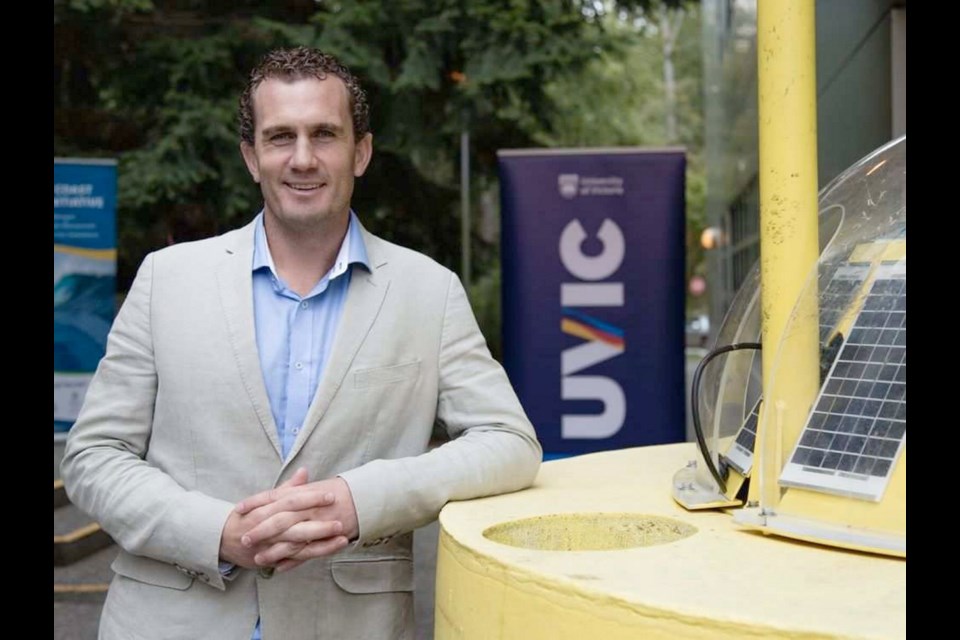B.C. has some of the best wave-energy potential anywhere in the world and with better government support and jurisdictional clarity, this province could be a global leader in developing the industry.
Those are some of the findings in a recent report out of the University of Victoria-led Pacific Institute for Climate Solutions.
There’s a lot going for wave power, as Bryson Robertson, the report’s lead author, explained in an interview this week.
Distant storms across the Pacific Ocean whip water up into an endless supply of energy-packed waves bound for the B.C. shoreline. By the time those waves arrive on this coast they’re so powerful that wave-energy converters in B.C. waters could generate from them as much as 324 terawatt hours annually.
That’s six times the province’s existing energy requirements, the authors found.
But there are jurisdictional issues holding up companies in the industry, Robertson said, adding that “they don’t know who to talk to” between and within Victoria and Ottawa. And once they do find the right contacts, they hear different requests from the two governments. It’s a problem Robertson claimed extends to any firm that relies on sea-floor-mounted technology, including those interested in building offshore wind farms.
When asked about this concern, a spokesperson at the provincial Ministry of Energy and Mines said they wouldn’t comment during an election period. A federal spokeswoman at Natural Resources Canada, meanwhile, replied with a statement that the government was committed “to developing a legislative framework for (such projects) in the federal offshore.”
There’s another big problem with wave energy: Cost.
Electricity generated from waves is now estimated to run between $390 and $1,450 per MWh. That’s roughly four to 14 times B.C.’s residential consumer rate, according to the report. The wide range was attributed to varied construction and operating costs, and uncertainty around permitting and power output.
When asked whether he saw wave power as a truly viable source of electricity, Robertson said: “Not in the immediate future. Not tomorrow.”
But he predicts the financial picture to improve and the energy source to come into its own.
“The costs are going to go down. If we look at all of our other energy-generating technologies, they were all exceedingly expensive off the bat. You have no economies of scale, you’re testing multiple technologies, concepts, ideas and methods, and a lot of them don’t work.”
There are a few different types of wave-energy converters in use or in development and the report detailed a few of them.
There are anchored buoys, which rely on floats and the up-and-down motion of swells to drive their hydraulic cylinders, and wormlike chains of floats that use motion at their hinges to generate electricity. There are wall-like flaps that lean back and forth in the waves, and that drive hydraulic rams at their bases on the sea floor. And there are elevated reservoirs that catch and convert surging water with help from gravity.
The converters are massive and just a single one of them, anchored in the right place, could produce enough energy to power more than 50 homes, according to the report, which used a prime location off Ucluelet as a case study.
With B.C.’s abundant and cheap supply of hydroelectricity, it’s hard to see wave energy ever being cost-competitive in this province, broadly speaking.
But it may make sense in some communities. As the authors note, many coastal communities are found at the extreme ends of the electrical grid, where blackouts are more frequent.
And some communities aren’t hooked up to the grid at all, but rather rely on diesel generators, which run five or six times the residential consumer rate, Robertson said.
Because B.C. has such wave-energy potential relative to other locations and some communities could use it, Robertson says domestic governments should help foster the industry — perhaps with funding and certainly with a more-streamlined permitting process.



